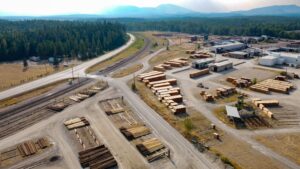
Choosing among LCA and sustainability tools isn’t about “nice-to-haves” – it directly affects your team’s workflow and how smoothly you can support reporting to evolving frameworks. Different platforms emphasise different strengths (expert modelling, packaged workflows, data-exchange automation, onboarding), so the right fit depends on your use case, data landscape, and assurance needs.
Alternatives to SimaPro, such as Ecochain, are often evaluated by teams seeking workflow-oriented UX, automated data exchange with ERP/PLM/SCM (scheduled or event-driven, depending on setup), and guided exports/workflows to support reporting.
This guide summarises seven commonly considered options so you can match capabilities to your team’s requirements.
Why Companies are Exploring SimaPro Alternatives
SimaPro provides advanced, transparent, method-driven LCA modelling – one reason it’s widely used by researchers and expert practitioners. That depth can come with a steeper learning curve and more configuration, which some organisations are comfortable with and others prefer to streamline.
For teams prioritising packaged connectors, guided workflows, and managed onboarding, it can be useful to compare additional platforms alongside SimaPro. Rather than characterising any tool as “limited,” a practical approach is to validate the degree of turnkey automation you need (e.g., supplier/Scope 3 data pipelines; ERP/PLM/SCM connections) and confirm what’s available out of the box versus via configuration or services.
Modern LCA platforms like Ecochain emphasise intuitive dashboards, collaboration-friendly UX, and automated data exchange that reduces manual handling. Cost and resourcing also matter: some teams prefer expert-grade modelling environments; others prioritise faster onboarding and standardised workflows. The most reliable way to decide is to run a guided pilot on your own data and measure time-to-value.
SimaPro and PRé Sustainability are now part of One Click LCA. Product names/capabilities may evolve – verify latest modules and plans when comparing.
Key Features to Evaluate When Comparing SimaPro Alternatives

Choosing among LCA and sustainability platforms isn’t trivial – each emphasizes different strengths. The decision directly shapes your team’s workflow efficiency and how reliably you can support emerging reporting requirements.
A few of the features that you should look out for include:
Level of Automation
Manual data work is slow and error-prone. Prioritise platforms that reduce copy-paste and spreadsheet handling with automated data capture and processing so teams can spend more time on reduction initiatives, not admin.
Connectivity with Data Sources
To realise the benefits of automation, look for automated data exchange with ERP/PLM/SCM and supplier systems – scheduled or event-driven, depending on setup. This helps keep inventories current across Scope 1, 2, and 3 and supports faster, better-informed decisions.
Reporting support (CSRD / ISO 14040/44)
Regulatory expectations are expanding. Choose tools that provide guided workflows and exports to support reporting aligned to CSRD and ISO 14040/44 (not legal advice). Clarify what’s available out of the box versus what requires configuration or services.
Scalability
Your platform should grow with your footprint – across products, facilities, and regions. Consider deployment model, data volumes, and collaboration needs; cloud deployments can help with elastic capacity and multi-team access.
Ease of Use and Onboarding
User-friendly dashboards, clear visuals, and role-based workflows shorten time-to-value. Look for structured onboarding, training, and responsive support so your team ramps quickly and stays productive.
EcoChain: A Leading Alternative to SimaPro for Comprehensive Life-Cycle Assessments
Ecochain is a workflow-oriented, cloud-based LCA platform designed to make day-to-day work more efficient. It pairs intuitive dashboards with automated data exchange to ERP/PLM/SCM and supplier systems – scheduled or event-driven, depending on setup – so teams spend less time on manual handling. Clear, shareable visuals help surface hotspots across products and supply chains, supporting faster, better-informed decisions.
Adoption is also a focus. Structured onboarding, training, and responsive support help teams get productive quickly. Once live, practitioners can use Scope 1–3 tracking and guided workflows/exports aligned to frameworks such as CSRD and ISO 14040/44 (not legal advice), which reduces spreadsheet work and helps standardise reporting.
SimaPro remains a strong choice for expert users who need deep, transparent, method-driven modelling. In practice, it may require more configuration for integrations and report templates, and its deployment approach differs (teams should confirm cloud/desktop options and governance needs). Many organisations compare both platforms to match the tool to their skills, data flows, and reporting processes.
What to verify when choosing between Ecochain and SimaPro
- Data connections: required systems, two-way needs, and whether updates are scheduled or event-driven.
- Reporting support: which CSRD/ISO artefacts and exports are available out of the box vs. via configuration or services.
- Ease of use & onboarding: dashboards, training, and support SLAs for your team.
- Deployment & scalability: cloud capacity, collaboration needs, and administration/governance controls.
This combination of automated data capture, collaboration-friendly dashboards, and workflow support makes Ecochain a strong option for manufacturing and supply-chain teams that want to streamline LCAs and framework-aligned reporting. By reducing manual handling and standardising inputs, teams can spend more time on product and process improvements that lower emissions.
Capabilities vary by plan, region, and implementation – always confirm modules, integrations, and SLAs in your agreement.
GaBi: A Veteran in the Life-Cycle Assessment Software Space
GaBi is a long-established LCA platform known for methodological depth and extensive industry datasets. It supports assessments across sectors such as automotive, electronics, construction, and consumer goods, and is frequently used where product and supply-chain complexity is high.
Its strengths include granular scenario and sensitivity analysis, broad, sector-specific databases, and specialised modules that can increase relevance for particular industries. These capabilities help trained teams model intricate supply networks and perform detailed impact assessments; they can also support the preparation of framework-aligned reporting packages (e.g., aligning with ISO 14040/44), depending on configuration and process design.
Because of its breadth and configurability, GaBi typically benefits expert users and clear modelling governance. The interface and setup can present a steeper learning curve; organisations prioritising rapid onboarding and highly guided workflows may prefer tools that emphasise packaged processes and out-of-the-box templates. As always, the best fit depends on your data landscape, expertise, and reporting needs.
openLCA: The Open-Source SimaPro Alternative for Customizable Life-Cycle Assessments
As an open-source tool, openLCA gives method-savvy users fine-grained control to build customised LCA models tailored to specific products, processes, or industries. This adaptability often appeals to academics, SMBs, and organisations that require bespoke modelling setups or want transparency into methods and data handling.
openLCA can be used with leading life-cycle inventory (LCI) databases—such as ecoinvent or ELCD—subject to the relevant licences. Its modelling-first interface enables skilled practitioners to construct, configure, and refine detailed assessments across product life cycles and supply chains.
Where openLCA is strong
- Open-source licensing and transparency, which can help manage software costs and enable method control
- High customisability for advanced modelling and workflows
- Compatibility with major LCI databases (licensing required where applicable)
- Active community resources (documentation, forums, plug-ins)
Trade-offs to plan for
Because openLCA emphasises modelling control, it may require more configuration, template work, or scripting to streamline day-to-day workflows. Data collection and reporting can involve manual steps or DIY integrations when turnkey connectors and guided templates are not in place. Teams that prioritise packaged workflows, automated data exchange with ERP/PLM/SCM, and guided reporting may prefer to evaluate managed platforms alongside openLCA.
Ultimately, the best choice depends on your team’s skills, data landscape, and assurance needs; many organisations prototype in openLCA and compare it with workflow-oriented tools before deciding.
Umberto and Air.e LCA: Specialized Alternatives to SimaPro
For teams that prioritise visual analytics and ease of use, Umberto and Air.e LCA offer focused approaches that complement expert-modelling tools.
Umberto blends clear, diagram-based visualisations with method-driven modelling. Its flow diagrams help users trace resource and emission pathways, surface hotspots, and communicate findings across technical and non-technical stakeholders. This graphic approach can make complex inventories easier to interpret and discuss across functions. Where relevant, Umberto can support reporting aligned to recognised frameworks (e.g., ISO 14040/44) through documentation and exports; as always, confirm what’s provided out of the box versus configuration or services.
Air.e LCA emphasises quick turnarounds through a streamlined interface and simplified workflows. The focus is on helping teams produce decision-ready results with short learning curves, guided data entry, and assisted calculations, which can reduce the time and effort required to complete standard assessments.
Typical strengths
- Umberto: visual analytics and flow diagrams that aid hotspot identification and stakeholder communication; method-driven modelling with documentation to support framework-aligned reporting.
- Air.e LCA: fast onboarding, simplified data workflows, and efficient generation of core impact metrics for teams seeking speed and clarity.
Fit considerations
Both platforms address specific needs. If visual storytelling and cross-functional communication are central, Umberto’s diagram-led approach can be compelling. If speed and process simplicity are the priority, Air.e LCA may suit teams looking to minimise complexity. In all cases, validate required datasets, integration options, and reporting outputs for your use case and plan.
Emerging Trends Shaping Future Choices of SimaPro Alternatives
As regulatory expectations tighten, it’s worth looking at how sustainability platforms are evolving before you decide what to adopt. Four trends come up repeatedly in evaluations:
AI-assisted analytics
Vendors are embedding AI and machine learning to speed analysis and surface actionable insights. Used well, these tools can automate repetitive calculations, highlight likely hotspots, and help estimate impacts where data are sparse. Accuracy still depends on data quality, scope, and assumptions, so expert review remains essential.
Cloud-based collaboration
Cloud deployments make it easier to share workspaces, keep inventories more current via automated data exchange with ERP/PLM/SCM (scheduled or event-driven, depending on setup), and coordinate across sites and teams. Many organisations now treat these collaboration features as baseline for multi-stakeholder programs.
Digital product passports (DPPs)
DPP initiatives aim to increase product-level transparency by linking sustainability attributes and documentation to items throughout the value chain. As pilots and standards mature, platforms are adding capabilities to capture and surface these attributes alongside LCA results.
Scenario planning
Modern tools are expanding what-if analysis – letting teams compare materials, suppliers, and process changes to understand potential environmental and cost trade-offs. This supports more informed target-setting and prepares organisations for evolving disclosure requirements.
Platforms such as Ecochain emphasise these directions – pairing workflow-oriented UX with data exchange, collaboration, and planning features – so teams can reduce manual effort and make decisions with greater confidence. Capabilities vary by vendor, plan, and implementation; verify definitions, integrations, and outputs against your specific use case.
Practical Tips for Transitioning to a SimaPro Alternative
Switching from SimaPro to another LCA platform works best with a clear plan. Use the checklist below to streamline the process and reduce surprises.
1) Develop a clear data-migration strategy
Inventory your current studies (methods, databases/versions, units, impact categories, custom factors) and map them to the target platform’s data model. Confirm import/export formats, database entitlements (e.g., ecoinvent licensing), and how references will be preserved. Run a small pilot migration to reconcile results before scaling.
Example: Platforms such as Ecochain provide migration/mapping utilities and implementation guidance—validate these on a sample study to check effort and fidelity.
2) Assess scalability and integration needs
Estimate future footprint (products/BOMs, sites, users) and the systems you need to connect. Look for automated data exchange with ERP/PLM/SCM and supplier systems—scheduled or event-driven, depending on setup—and clarify one-way vs two-way sync, error handling, and monitoring. Choose a deployment model (e.g., cloud) that supports collaboration and growth.
3) Make use of training and onboarding support
Plan role-based enablement (practitioners, reviewers, admins) and request structured onboarding, documentation, and SLA-backed support. A sandbox plus hands-on sessions typically shortens time-to-value.
4) Prioritise reporting workflows (not “automated compliance”)
Seek guided workflows and exports that support reporting aligned to CSRD and ISO 14040/44 (not legal advice). Confirm what’s available out of the box vs what requires configuration or services. Define the evidence you’ll retain (data lineage, assumptions, sign-offs).
5) Define acceptance criteria and run a pilot
Agree on measurable targets—e.g., time to replicate a reference study, % of data flows automated, review/approval cycle time, and user adoption. Test on your own data and lock findings into the rollout plan.
6) Don’t forget portability and governance
Confirm data/model export options, admin roles, audit trails, and how you’ll manage updates to databases/methods. This reduces switching risk later and supports audits.
How Ecochain can fit (example, verify for your plan)
- Data migration & integration: utilities and services to map existing models; automated data exchange with core systems (scheduled/event-driven, per configuration).
- Onboarding & support: structured training and customer-success resources to accelerate ramp-up.
- Reporting support: guided exports/workflows aligned to CSRD/ISO 14040/44 to help standardise documentation and reduce manual collation.
Results (e.g., shorter report-prep cycles) depend on scope, data quality, and execution – validate expected gains in a pilot rather than relying on generic percentages.
Final Words
SimaPro enables expert teams to produce detailed, transparent LCA studies. At the same time, some organisations prioritise different trade-offs – such as packaged workflows, data-exchange automation, and structured onboarding – and therefore evaluate additional platforms.
Alternatives like Ecochain, GaBi, openLCA, Umberto, and Air.e LCA each bring a distinct mix of strengths. By mapping capabilities to your use cases (data sources, reporting needs, team skills, governance), you can select a toolset that streamlines day-to-day work and supports framework-aligned reporting.
Frequently Asked Questions for Evaluating SimaPro Alternatives in LCA Software
Organizations often have similar questions when exploring the options for alternatives to SimaPro.
Here are answers to the most common which can help sustainability professionals make informed choices:
What is the difference between SimaPro and GaBi?
A: Both are established LCA platforms. SimaPro is known for method transparency and detailed product-system modelling. GaBi offers extensive sector-specific databases and scenario analysis often used in complex industry applications. The right fit depends on your modelling depth, datasets, and workflow preferences.
What is the best free software for life cycle assessment (LCA)?
A: openLCA is a widely used open-source platform. It offers flexibility and transparency and can work with major LCI databases (e.g., ecoinvent, ELCD) subject to their licences. It’s suitable for teams that are comfortable configuring models and templates.
Are there user-friendly alternatives to SimaPro suitable for smaller businesses?
A: Many teams evaluate Ecochain or Air.e LCA when they prioritise a shorter learning curve, guided workflows, and clear dashboards. The safest approach is to run a guided pilot on your own data to validate time-to-value.
How can businesses ensure smooth data migration when transitioning from SimaPro to another LCA software?
A: Create a migration plan: inventory your current studies, map methods and databases to the target platform, confirm import/export formats and licences, and run a small pilot migration to reconcile results. Vendor onboarding and implementation support can reduce effort and risk.
How do I select the best LCA software substitute for my organization’s specific needs?
A: Start with requirements: scope (products/sites), reporting frameworks (e.g., CSRD, ISO 14040/44), integration needs (ERP/PLM/SCM), user roles, and governance. Shortlist 2–3 tools and pilot them against acceptance criteria (e.g., % data flows automated, time to replicate a reference study, reviewer cycle time, export outputs).
How challenging is data migration from SimaPro to another platform?
A: It varies by study complexity, database versions, and target tooling. With a structured plan – plus vendor migration utilities and training – teams typically limit disruption and reach parity faster.
Are there SimaPro alternatives suitable for both small and large organizations?
A: Yes. Several platforms offer cloud deployments and role-based access that can scale from small teams to multi-site enterprises. When comparing, verify automated data exchange options (scheduled or event-driven, depending on setup), onboarding/support, and governance controls.
Notes:
Tools can support reporting aligned to frameworks such as CSRD and ISO 14040/44, but software does not by itself guarantee compliance. Capabilities vary by plan, region, and implementation—confirm modules, integrations, and SLAs in your agreement.
SimaPro and PRé Sustainability are now part of One Click LCA. Product names/capabilities may evolve – verify latest modules and plans when comparing.



